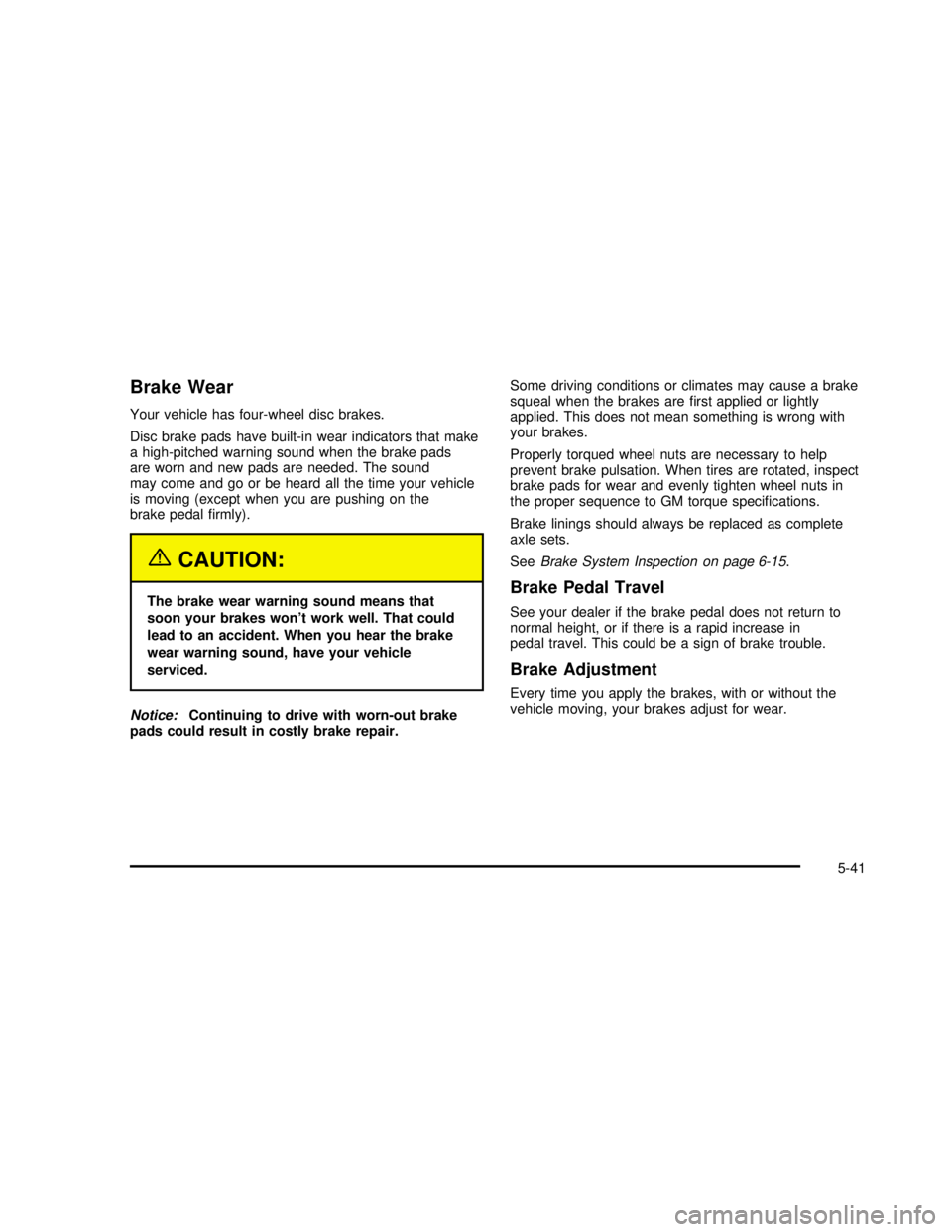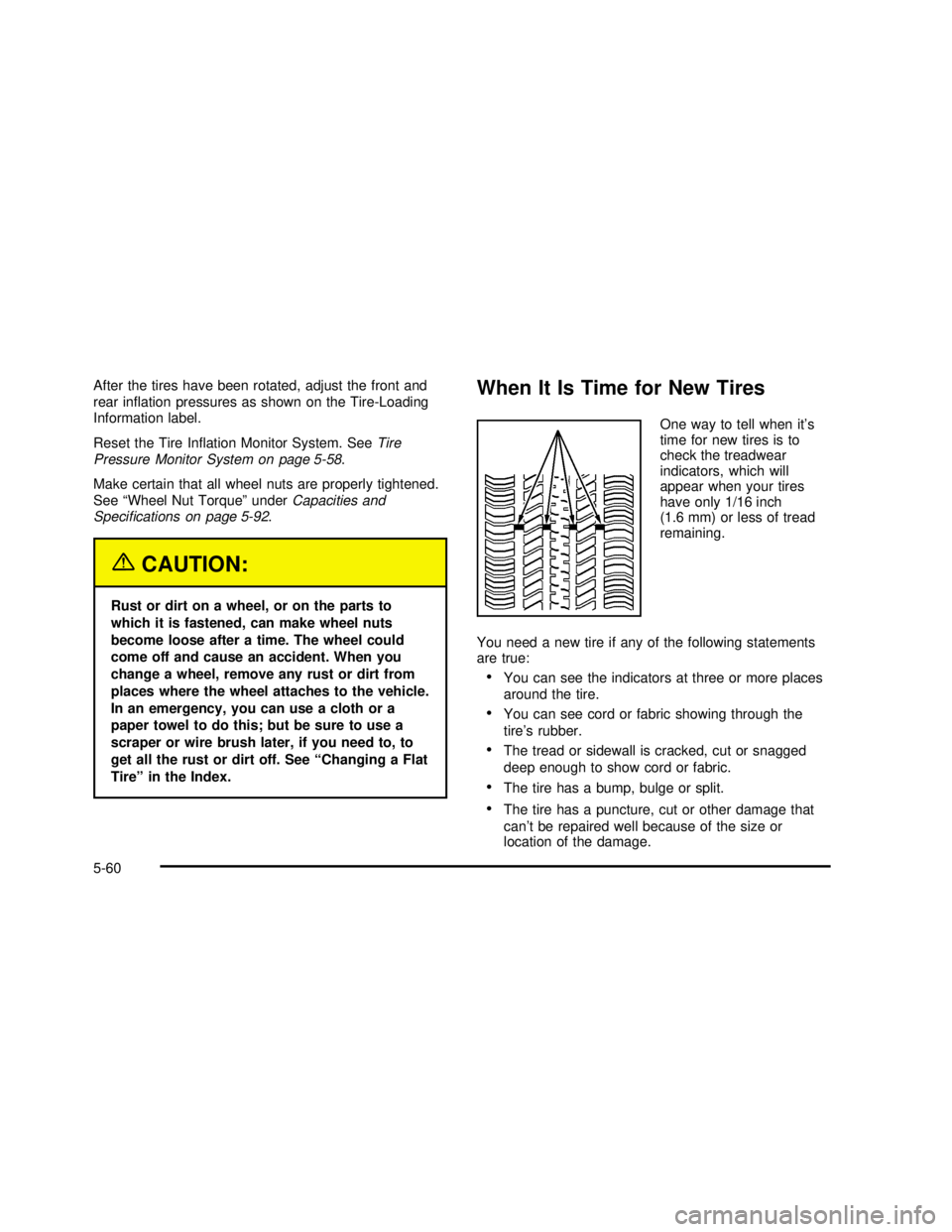Time set BUICK REGAL 2003 Owner's Guide
[x] Cancel search | Manufacturer: BUICK, Model Year: 2003, Model line: REGAL, Model: BUICK REGAL 2003Pages: 344, PDF Size: 2.21 MB
Page 241 of 344

Brake Wear
Your vehicle has four-wheel disc brakes.
Disc brake pads have built-in wear indicators that make
a high-pitched warning sound when the brake pads
are worn and new pads are needed. The sound
may come and go or be heard all the time your vehicle
is moving (except when you are pushing on the
brake pedalfirmly).
{CAUTION:
The brake wear warning sound means that
soon your brakes won’t work well. That could
lead to an accident. When you hear the brake
wear warning sound, have your vehicle
serviced.
Notice:Continuing to drive with worn-out brake
pads could result in costly brake repair.Some driving conditions or climates may cause a brake
squeal when the brakes arefirst applied or lightly
applied. This does not mean something is wrong with
your brakes.
Properly torqued wheel nuts are necessary to help
prevent brake pulsation. When tires are rotated, inspect
brake pads for wear and evenly tighten wheel nuts in
the proper sequence to GM torque specifications.
Brake linings should always be replaced as complete
axle sets.
SeeBrake System Inspection on page 6-15.Brake Pedal Travel
See your dealer if the brake pedal does not return to
normal height, or if there is a rapid increase in
pedal travel. This could be a sign of brake trouble.
Brake Adjustment
Every time you apply the brakes, with or without the
vehicle moving, your brakes adjust for wear.
5-41
2003 - Regal OM
Page 258 of 344

Tire Pressure Monitor System
If your vehicle has the tire inflation monitor system, it
can alert you to a large change in the pressure of
one tire. The system“learns”the pressure at each tire
throughout the operating speed range of your vehicle.
The system normally takes between 45 and 90 minutes
of driving to learn the tire pressures. This time may
be longer depending on your individual driving habits.
Learning need not be accumulated during a single
trip. Once learned, the system will remember the tire
pressures until the system is recalibrated.
After the system has learned tire pressures with properly
inflated tires, the LOW TIRE light will come on if the
pressure in one tire becomes 12 psi (83 kPa) lower than
the other three tires. The tire inflation monitor system
won’t alert you if the pressure in more than one tire is low,
if the system is not properly calibrated, or if the vehicle is
moving faster than 70 mph (110 km/h).
The tire inflation monitor system detects differences in
tire rotation speeds that are caused by changes in
tire pressure. The system can alert you about a low
tire—but it doesn’t replace normal tire maintenance.
SeeTires on page 5-56.When the LOW TIRE light comes on, you should stop
as soon as you can and check all your tires for damage.
(If a tire isflat, seeIf a Tire Goes Flat on page 5-66.)
Also check the tire pressure in all four tires as soon as
you can. SeeInflation—Tire Pressure on page 5-57.
The LOW TIRE light will also be displayed (while
the ignition is on) until you reset (calibrate) the system.
Don’t reset the tire inflation monitor system without
first correcting the cause of the problem and checking
and adjusting the pressure in all four tires. If you
reset the system when the tire pressures are incorrect,
the system will not work properly and may not alert
you when a tire is low.
Any time you adjust a tire’s pressure, rotate your tires,
or have one or more tires repaired or replaced, you’ll
need to reset (calibrate) the tire inflation monitor system.
You’ll also need to reset the system whenever you
buy new tires and whenever the vehicle’s battery has
been disconnected.
To reset (calibrate) the system:
1. Turn the ignition to RUN.
2. Locate the red RESET button inside of your
instrument panel fuse block.
The fuse block is located under the cover labeled
FUSES, which is at the end of the instrument panel
on the passenger’s side of the vehicle. The
RESET button is thefirst button in the top row of
the fuse block.
5-58
2003 - Regal OM
Page 259 of 344

3. Press and hold the RESET button for aboutfive
seconds.
The LOW TIRE light will come on andflash three
times. Then it will go off. If the light doesn’tgo
off, see your dealer for service.
The system completes the calibration process during
driving.
The system normally takes 15 to 20 minutes of driving
in each of three speed ranges to“learn”tire pressures.
The speed ranges are 15 to 40 mph (25 to 65 km/h),
40 to 65 mph (65 to 105 km/h) and above 65 mph
(105 km/h). When learning is complete, the system will
alert you after two to eight minutes if a tire is 12 psi
(83 kPa) different from the other three tires. Detection
thresholds may be higher and detection times may
be longer on rough roads, curves and at high speeds.
The system is not capable of detection at speeds greater
than 70 mph (110 km/h).Tire Inspection and Rotation
Tires should be rotated every 7,500 miles (12 500 km).
Any time you notice unusual wear, rotate your tires
as soon as possible and check wheel alignment. Also
check for damaged tires or wheels. SeeWhen It Is Time
for New Tires on page 5-60andWheel Replacement
on page 5-63for more information.
The purpose of regular rotation is to achieve more
uniform wear for all tires on the vehicle. Thefirst rotation
is the most important. See“Part A: Scheduled
Maintenance Services,”in Section 6, for scheduled
rotation intervals.
When rotating your tires, always use the correct rotation
pattern shown here.
Don’t include the compact spare tire in your tire rotation.
5-59
2003 - Regal OM
Page 260 of 344

After the tires have been rotated, adjust the front and
rear inflation pressures as shown on the Tire-Loading
Information label.
Reset the Tire Inflation Monitor System. SeeTire
Pressure Monitor System on page 5-58.
Make certain that all wheel nuts are properly tightened.
See“Wheel Nut Torque”underCapacities and
Specifications on page 5-92.
{CAUTION:
Rust or dirt on a wheel, or on the parts to
which it is fastened, can make wheel nuts
become loose after a time. The wheel could
come off and cause an accident. When you
change a wheel, remove any rust or dirt from
places where the wheel attaches to the vehicle.
In an emergency, you can use a cloth or a
paper towel to do this; but be sure to use a
scraper or wire brush later, if you need to, to
get all the rust or dirt off. See“Changing a Flat
Tire”in the Index.
When It Is Time for New Tires
One way to tell when it’s
time for new tires is to
check the treadwear
indicators, which will
appear when your tires
have only 1/16 inch
(1.6 mm) or less of tread
remaining.
You need a new tire if any of the following statements
are true:
•You can see the indicators at three or more places
around the tire.
•You can see cord or fabric showing through the
tire’s rubber.
•The tread or sidewall is cracked, cut or snagged
deep enough to show cord or fabric.
•The tire has a bump, bulge or split.
•The tire has a puncture, cut or other damage that
can’t be repaired well because of the size or
location of the damage.
5-60
2003 - Regal OM
Page 263 of 344

Temperature–A, B, C
The temperature grades are A (the highest), B, and C,
representing the tire’s resistance to the generation
of heat and its ability to dissipate heat when tested
under controlled conditions on a specified indoor
laboratory test wheel. Sustained high temperature can
cause the material of the tire to degenerate and
reduce tire life, and excessive temperature can lead to
sudden tire failure. The grade C corresponds to a
level of performance which all passenger car tires must
meet under the Federal Motor Vehicle Safety Standard
No. 109. Grades B and A represent higher levels of
performance on the laboratory test wheel than the
minimum required by law.
Warning: The temperature grade for this tire is
established for a tire that is properly inflated and not
overloaded. Excessive speed, underinflation, or
excessive loading, either separately or in combination,
can cause heat buildup and possible tire failure.
Wheel Alignment and Tire Balance
The wheels on your vehicle were aligned and balanced
carefully at the factory to give you the longest tire life
and best overall performance.
Scheduled wheel alignment and wheel balancing are
not needed. However, if you notice unusual tire wear or
your vehicle pulling one way or the other, the alignment
may need to be reset. If you notice your vehicle
vibrating when driving on a smooth road, your wheels
may need to be rebalanced.
Wheel Replacement
Replace any wheel that is bent, cracked or badly rusted
or corroded. If wheel nuts keep coming loose, the
wheel, wheel bolts and wheel nuts should be replaced.
If the wheel leaks air, replace it (except some
aluminum wheels, which can sometimes be repaired).
See your dealer if any of these conditions exist.
Your dealer will know the kind of wheel you need.
5-63
2003 - Regal OM
Page 299 of 344

Footnotes
†The U.S. Environmental Protection Agency or the
California Air Resources Board has determined that the
failure to perform this maintenance item will not nullify
the emission warranty or limit recall liability prior to
the completion of the vehicle ’s useful life. We, however,
urge that all recommended maintenance services be
performed at the indicated intervals and the
maintenance be recorded.
@Whenever the tires are rotated, the Tire In�ation
Monitor System must be reset.
+A good time to check your brakes is during tire
rotation. See Brake System Inspection on page 6-15.
Engine Oil Scheduled Maintenance
Change engine oil and filter as indicated by the
GM Oil Life System (or every 12 months, whichever
occurs first). Reset the system.
Your vehicle has a computer system that lets you know
when to change the engine oil andfilter. This is
based on engine revolutions and engine temperature,
and not on mileage. Based on driving conditions,
the mileage at which an oil change will be indicated can
vary considerably. For the oil life system to work
properly, you must reset the system every time the oil is
changed.When the system has calculated that oil life has been
diminished, it will indicate that an oil change is
necessary. A CHANGE OIL SOON light will come on.
Change your oil as soon as possible within the next two
times you stop for fuel. It is possible that, if you are
driving under the best conditions, the oil life system may
not indicate that an oil change is necessary for over a
year. However, your engine oil andfilter must be
changed at least once a year and at this time the system
must be reset. Your dealer has GM-trained service
people who will perform this work using genuine GM
parts and reset the system.
It is also important to check your oil regularly and keep
it at the proper level.
If the system is ever reset accidentally, you must
change your oil at 3,000 miles (5 000 km) since your
last oil change. Remember to reset the oil life system
whenever the oil is changed. SeeEngine Oil on
page 5-13for information on resetting the system.
An Emission Control Service.
See the mileage intervals following for additional
services that may be performed with an engine oil
change. After the services are performed, record the
date, odometer reading and who performed the service
on the maintenance record pages in Part E of this
schedule.
6-5
2003 - Regal OM
Page 327 of 344

A
Accessory Power Outlets.................................3-15
Activating the Theft-Deterrent Feature................3-55
Adding Washer Fluid.......................................5-38
Additional Program Information........................... 7-9
Additives, Fuel................................................. 5-5
Add-On Electrical Equipment............................5-86
Adjusting the Speakers (Balance/Fade)......3-47, 3-51
Air Bag
Readiness Light..........................................3-30
Air Bag Systems.............................................1-46
How Does an Air Bag Restrain?....................1-52
Servicing Your Air Bag-Equipped Vehicle.........1-54
What Makes an Air Bag Inflate?....................1-51
What Will You See After an Air Bag Inflates?......1-52
When Should an Air Bag Inflate?...................1-51
Where Are the Air Bags?..............................1-49
Air Cleaner/Filter, Engine.................................5-18
Aluminum or Chrome-Plated Wheels..................5-82
AM ...............................................................3-57
Antenna, Backglass.........................................3-59
Anti-lock Brake System (ABS)............................ 4-7
Anti-Lock Brake, System Warning Light..............3-32
Appearance Care............................................5-77
Care of Safety Belts....................................5-80
Chemical Paint Spotting...............................5-83
Cleaning the Inside of Your Vehicle................5-78Appearance Care (cont.)
Cleaning the Outside of Your Vehicle..............5-80
Finish Damage............................................5-83
GM Vehicle Care/Appearance Materials..........5-84
Sheet Metal Damage...................................5-83
Underbody Maintenance...............................5-83
Weatherstrips..............................................5-80
Ashtrays........................................................3-17
Audio System(s).............................................3-44
Audio Steering Wheel Controls......................3-57
Backglass Antenna......................................3-59
Care of Your Cassette Tape Player
................3-58
Care of Your CD Player
...............................3-59
Care of Your CDs
........................................3-59
Radio with Cassette
.....................................3-45
Radio with Cassette and CD
.........................3-49
Setting the Time
..........................................3-45
Theft-Deterrent Feature
................................3-55
Understanding Radio Reception
.....................3-57
Automatic Operation
........................................3-20
Automatic Transaxle
Fluid
..........................................................5-20
Operation
...................................................2-21
Automatic Transaxle Check
..............................6-11
Automatic Transaxle Shift Lock Control
System Check
.............................................6-12
Auxiliary Power Connection (Power Drop)
...........3-16
1
2003 - Regal OM
Page 337 of 344

Power
Accessory Outlets........................................3-15
Auxiliary Connection.....................................3-16
Door Locks.................................................2-10
Drop ..........................................................3-16
Electrical System.........................................5-86
Six-Way Seats.............................................. 1-3
Steering Fluid.............................................5-36
Windows....................................................2-15
Power Steering...............................................4-12
Programmable Automatic Door Locks.................2-10
Programmable Modes......................................2-10
Q
Questions and Answers About Safety Belts.........1-11
R
Radiator Pressure Cap....................................5-25
Radios..........................................................3-44
Care of Your Cassette Tape Player................3-58
Care of Your CD Player...............................3-59
Care of Your CDs ........................................3-59
Radio with Cassette.....................................3-45
Radio with Cassette and CD.........................3-49Radios (cont.)
Setting the Time..........................................3-45
Theft-Deterrent............................................3-55
Understanding Reception..............................3-57
Reading Lamps..............................................3-15
Rear Safety Belt Comfort Guides......................1-24
Rear Seat Outside Passenger Positions.............1-21
Rear Seat Passengers, Safety Belts..................1-21
Rear Window Defogger............................3-19, 3-23
Rearview Mirror, Automatic Dimming..................2-32
Rearview Mirror, Automatic Dimming
with OnStar
®..............................................2-32
Rearview Mirror with OnStar®...........................2-31
Rearview Mirrors.............................................2-31
Reclining Seatbacks.......................................... 1-4
Recreational Vehicle Towing
.............................4-31
Remote Keyless Entry System
............................ 2-3
Remote Keyless Entry System, Operation
............ 2-4
Remote Trunk Release
....................................2-12
Removing the Flat Tire and Installing
the Spare Tire
.............................................5-70
Removing the Spare Tire and Tools
...................5-67
Removing the Wheel Center Caps
....................5-69
Removing the Wheel Covers
............................5-70
Replacement Bulbs
.........................................5-55
Replacing Brake System Parts
..........................5-42
11
2003 - Regal OM
Page 339 of 344

Sensors.........................................................3-22
Service........................................................... 5-3
Adding Equipment to the Outside of Your
Vehicle..................................................... 5-4
Doing Your Own Work................................... 5-3
Engine Soon Light.......................................3-35
Publications Ordering Information...................7-10
Vehicle Soon Light.......................................3-41
Service Bulletins.............................................7-11
Service Engine Soon Light...............................3-35
Service Manuals.............................................7-10
Setting Preset Stations............................3-46, 3-50
Setting the Time.............................................3-45
Setting the Tone (Bass/Treble)..................3-47, 3-51
Sheet Metal Damage.......................................5-83
Shift Lock Release..........................................2-27
Shifting Into Park (P).......................................2-25
Shifting Out of Park (P)...................................2-27
Shoulder Belt Height Adjuster...........................1-14
Skidding........................................................4-16
Some Other Rainy Weather Tips.......................4-20
Special Fabric Cleaning Problems.....................5-79
Specifications, Capacities.................................5-92
Speedometer..................................................3-28
Split Folding Rear Seat
..................................... 1-6
Starter Switch Check
.......................................6-12
Starting Your Engine
.......................................2-19Steering........................................................4-12
Steering in Emergencies..................................4-13
Steering, Suspension and Front Drive Axle Boot
and Seal Inspection.....................................6-14
Steering Tips..................................................4-12
Steering Wheel Controls, Audio.........................3-57
Storage Areas
Center Console Storage Area........................2-35
Convenience Net.........................................2-36
Glove Box..................................................2-35
Storing the Flat Tire and Tools..........................5-75
Storing the Spare Tire and Tools.......................5-76
Stuck in Sand, Mud, Ice or Snow......................4-30
Sun Visors.....................................................2-15
Sunroof.........................................................2-36
T
Tachometer....................................................3-29
Taillamps
Turn Signal, and Stoplamps..........................5-53
TCS Warning Light..........................................3-33
Theft-Deterrent, Radio.....................................3-55
Theft-Deterrent Systems...................................2-16
PASS-Key
®II ..............................................2-16
Throttle System Inspection...............................6-15
Tilt Wheel........................................................ 3-5
13
2003 - Regal OM